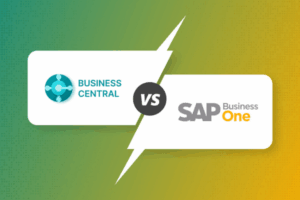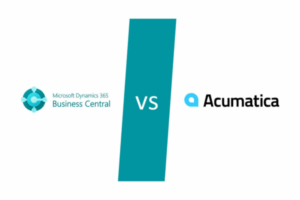What is Medical Device ERP? Functions and Working
There’s a word for this market and it’s “MedTech,” a portmanteau of “medical” and “technology.” However, we are more focused on the product manufacturing aspect of MedTech. Did you know that America has the largest share of this industry, larger than any other country in the world? Statistics show that around 40% of global medical device manufacturing happens in the US. That’s why US-based companies are more vulnerable to tech disruptions, a problem they can overcome with ERP.
So, what does medical ERP do? In general, ERP solutions have found their use in multiple industries in the world, such as cannabis, construction, cybersecurity, finance, and others. These tools make sure that these industries operate efficiently without any production delays. This is what medical device ERP does as well. In simple words, this solution will perform the following actions:
- Handling large numbers of product permutations with item variants management
- Multi-level bill of materials management with real-time updates/upgrades
- Product planning and control with job cards and workstations
- Batch management to track manufacturing/expiration dates
- Optimized procurement and production with MRP
If you wish to streamline business operations and produce high-quality products while staying compliant with industry regulations, then you should get your hands on the best ERP solution. It’ll give your startup a much-needed competitive edge in the highly regulated and fast-paced medical device industry.
Key Benefits of Medical Device ERP Software
So, how do medical device manufacturer benefit from enterprise resource planning? In this section, we’ll explore the key benefits of medical device ERP to help you understand why more folks in the health industry are investing in it. Here are the major advantages of this software:
- Regulatory compliance: If you want to ensure compliance with FDA regulations, then install the perfect ERP solution in your company. It’ll help you comply with various national/international standards, such as TS13485 and ISO 9001. For that, ERP tools have special features (audit trails, quality management, documentation control, etc.).
- Better fulfillment: You can’t improve order fulfillment without gaining more visibility into major manufacturing operations. You’ll also need to oversee inventory and supply chain management. All of that becomes as easy as pie once you’ve integrated the right medical device ERP into your company.
- Warranty management: You need to provide post-sale service after selling the product. Surveys show that faulty medical devices lead to 80,000 fatalities and 2 million injuries in the US. Taking care of warranty claims and complaints will help you reduce these numbers. There’s no better or faster way to manage warranties and complaints than using an ERP tool.
- Product traceability: Whether you need backward lot traceability or forward lot traceability, it’s a good option to have medical device ERP at your disposal. It’ll keep a detailed record of each & every transaction. It’s a great way to ensure transparency when it comes to auditing.
- Cloud services: If you want to take advantage of cloud-based systems, then you should invest in a cloud-based ERP solution. It will offer you everything a cloud-based network can, i.e., flexibility and control along with scalability in an ever-evolving regulatory environment.
- Customer service: The best manufacturers are the ones who excel at keeping customers happy; you’ll be glad to know that ERP solutions can provide you with this essential service too. It gives you a complete overview of customers so you can promptly answer their queries.
- Increased sales: All in all, medical device ERP offers amazing benefits to business owners. If you are looking for increased sales and profitability, then you should invest in ERP. It’ll help you take your medical device manufacturing business to new heights.
Did you know that manufacturing a typical medical device can easily take 3 to 7 years? This is the time it takes to design a machine, create a prototype, manufacture it on a large scale, and bring it to the market in the end. That’s why you must only choose the best option available out there. In the next section, we will discuss the best practices for choosing medical device ERP.
Choosing the Ideal Medical Device ERP: Tips and Best Practices
You may wonder how to choose the perfect ERP solution to take your business to new heights. Did you know that 8 in 10 US-based medical device manufacturing companies are small-to-midsized enterprises (SMEs)? It means that the competition is tough and you have to be careful when choosing the right ERP tool for your business. However, these tips might help you make a wise decision:
- Key business function integration: It’s a no-brainer that you should choose an ERP system that’ll integrate all core business functions into a single database. Instead of using various applications that ultimately create information silos, put your eggs in a single basket for reduced data entry errors.
- Medical device traceability: Don’t forget that your medical devices must be traceable once they enter the supply chain. This tracking capability makes it easier to locate defective pieces. ERP tools that can provide this service must be your priority; they will ensure regulatory compliance with relevant authorities about medical device recall.
- Software compliance: Regulatory compliance isn’t enough; you should choose an ERP tool that complies with the latest regulatory standards. Can it keep a record of revisions and malfunctions in your medical device? Most medical device manufacturers have to comply with 21 CFR Part 11; however, you need an ERP tool that’s flexible enough to accommodate international standards.
- Keeps the supply chain visible: Also, your favorite ERP solution must give you real-time visibility into the supply chain. Some of the best medical device ERP solutions out there will let you take care of the inventory at batch and product levels. It will make the manufacturing phase far more efficient and much less time-consuming.
- Mass customization: Lastly, you should choose a tool that can accommodate medical devices of various shapes and sizes. This ERP solution must keep the data regarding the specifications of the components well-organized. That’s how your company will be able to produce everything – from stethoscopes to prosthetics – after implementing a singular medical device ERP solution.
You can see that these simple tips will help you choose the right medical device ERP solution. Among the ocean of enterprise resource planning software programs available online, you have to invest in one that comes equipped with the below-mentioned features.
Major Features
We know medical device ERP solutions provide automation. But what else do they have to offer? In this subsection, we’ll look at some of the most important features of these tech solutions:
- Compliance: The most important features of a medical device enterprise resource planning tool will be the ones to ensure compliance with government regulations. So, you’ll have features like quality control and audit trails (as described above). This software will keep a detailed record of all the documents – from the prototyping phase to the production stage – for compliance.
- Quality: As the manufacturer, you have to make sure that your product meets industry-specific operational standards. That’s how you can maintain a certain level of quality here. The right ERP solution will provide ample traceability (for product recalls) and track non-conformities to make sure that your medical devices pass the strictest of all operating procedures.
- Logistics: You’d want your favorite medical device ERP to let you optimize inventory levels. This practice will reduce the risk of stock-outs. Don’t forget that this essential feature helps you take care of sub-contracted operations smartly. It also makes the entire supply chain super-visible so you can spot any discrepancies in the medical device manufacturing procedure.
- Serialization: Did you know that the FDA approved 124 new medical devices in 2023? New ones are emerging in the market every year and it’s the manufacturer’s job to ascertain unique device identification. ERP tools provide a basic function that lets you keep track of every device not just after producing it but even when it’s sold and enters the supply chain. As explained before, it’s a great way to trace faulty devices or trace the ones that have been stolen.
- Integration: Most importantly, medical devices enterprise resource planning tools can assemble all core business functions in a single platform. You can easily offer integration between various departments, such as sales, quality assurance (QA), inventory, production, serialization, etc. You may also integrate with your medical billing software for much better results.
Now, we will discuss how to implement this ERP software in your organization successfully.
How to Implement Medical Device ERP Software?
The MedTech industry is growing in the United States. Data even estimates that the number of medical device manufacturers in America increased by 0.4% between 2022 and 2023. So, what does it mean for your business? It means that you should implement an ERP solution right away. Don’t worry; these easy, simple six steps will help you make sense of this implementation. You can just follow these steps to put ERP at the center of your business operations for increased efficiency:
- Evaluate your company’s needs: What’s your medical device manufacturing business searching for in an ERP solution? You need to specify your needs by clarifying the pain points that ERP may address. For instance, you may have problems with quality control or regulatory compliance. It’ll help you involve key stakeholders and justify this investment in front of them. Just ensure you’re prioritizing the key features necessary for your company’s operations.
- Choose the right medical device ERP: Next, you’ll have to compare different ERP solutions. Find the best one, i.e., the one that addresses your MedTech company’s pain points. Also, make sure that your choice is FDA-validated. Demos and pilots will help you check the system for the major functionalities. You should also consider the implementation timeline (explained below) along with scalability when choosing the right enterprise resource planning software.
- Plan the implementation process: Now, it’s time to start rolling it out company wide. You should come up with clear timelines and milestones. Delegate responsibilities to employees carefully as well as allocating ample resources to the implementation plan. In other words, you must make a person the project manager. Then you’ll have to establish communication channels to keep the teams engaged (and informed). It’ll take us to the next section, i.e., employee preparation.
- Make away for the ERP solution: In this stage, you’ll ensure buy-in and support from the leaders as well as managers. Give ample training to users, especially the ones working in production. They need to understand how to use this tool for accelerated medical device manufacturing. You should also establish clear SOPs for using the medical device ERP tool.
- Roll it out across the organization: Finally, you’ll start migrating data from the legacy systems to the new ERP tool. Just make sure that you’re monitoring the system regularly. Follow your timelines closely while providing ongoing support and troubleshooting during the transition period.
- Keep the ERP running smoothly: For that, you must continuously monitor and optimize the ERP system to improve efficiency and performance. Maintain system validation during this process. It is also important to conduct audits to check compliance. Leverage the ERP system’s reporting and analytics capabilities to drive data-driven decision-making.
In short, medical device manufacturers can successfully implement an ERP tool by following these steps and partnering with an experienced ERP implementation provider. Now, let’s discuss how to handle the cost of ERP implementation and how much time it’ll take to implement medical device ERP in a company that operates on a regional level.
The Cost of Implementation
How much does medical device ERP implementation cost? Well, it depends on several factors, such as:
- Software licensing fees can set you back from hundreds to tens of thousands of dollars. It depends on how many users there are and how many models are required. The per user per month pricing can range from about $75 all the way up to $300. This depends on the needs of your business and if you require an Enterprise size ERP or one suited for a medium to large sized business. For example, Microsoft Dynamics 365 Business Central starts at $75 while Microsoft Dynamics Finance and Operations tops out at $300 user/month.
- The cost of implementation is a wide range from $50,000 to $500,000 (or even more when it isn’t an SME we’re talking about). Data migration, training, and testing can be pretty expensive. It all depends on the amount of customizations needed and the size of you business. The hourly rate of your implementation partner has a large effect on price. This can also be a wide range with the average rate being around $225/hour.
- In case you want to implement the ERP solution on-premise, then you’ll have to invest in proper hardware and infrastructure as well. This can easily add thousands of dollars to the total cost.
- These systems need constant maintenance, costing 15 to 20 percent of the initial cost of getting the software license in the first place. This factor is true for all ERP solutions no matter if they’re related to medical device manufacturing or not.
- Don’t forget about the hidden costs of ERP implementation, such as customer development and change management. Even user training can cost you extra if you’re not careful enough.
In short, the total cost of implementing medical device ERP for SMEs (100+ employees) can be $250,000 to a whopping million dollars (or even more). Larger enterprises with more complex requirements may invest $6 million or more in their ERP implementation. So, you should create a realistic budget and then start implementing this system in your medical device manufacturing company.
The Duration of Implementation
You may also wonder how much time it takes to implement a resource planning tool. Again, it depends on many factors. Small businesses will implement it in less than four months. Large businesses require 9 to 18 months. However, multinational businesses often take years to implement. It all depends on the following factors:
- What sort of resources are available?
- Is it complex to convert or migrate data?
- Do you require customization and integration?
- What will be the scope of total ERP implementation?
In other words, SMEs should dedicate a full year to ERP implementation.
Final Thoughts
Now, you know how to choose the best medical device ERP to set your manufacturing company up for long-term success. Go through all the details provided in this article and you’ll soon observe your startup growing from the ground up – all thanks to robust tech integration.
So, become proactive instead of reactive to keep up in this ever-evolving industry. Feel free to schedule a discovery call with the professionals at Alchemy 365 to see how we can be your ERP partner of choice when it comes to finding and implementing an ideal solution.





